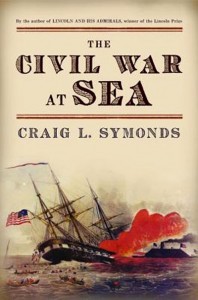 By Craig L. Symonds. Oxford University Press, New York, NY. (2012)
By Craig L. Symonds. Oxford University Press, New York, NY. (2012)
Reviewed by William Whyte
Renowned historian Craig Symonds, Professor of History Emeritus at the U.S. Naval Academy, has penned a compact, topical overview of the naval effects on the U.S. Civil War. Symonds has written a number of works on the Civil War, most notably Lincoln and His Admirals and a biography of Confederate Admiral Franklin Buchanan. This publication is in essence six stand-alone essays that serve to synthesize the many facets of naval operations during the conflict. The introductory chapter offers an overview of the resources for each side, combined with the state of naval technology during this transformative era.
Symonds not only emphasizes technological innovations during the war but prior to it as well. He purports that “…the U.S. Navy was far better prepared for war in 1861 than it had been for any previous American war (8),” thanks, in part, to a naval modernization effort began five years earlier. Another aspect of this technological transformation was the Union monitor program, which marked a conspicuous moment towards a modern industrial system. It was a novel procedure at the time to have parts manufactured in different locations and then assembled at various shipyards. Here the author draws upon Kurt Hackemer’s The U.S. Navy and the Origins of the Military Industrial Complex, as well as, William H. Roberts’ Civil War Ironclads. Perhaps the most insightful section covers the U.S. Navy’s largest contribution to the war effort: the coastal blockade.
The blockade of the Southern coast was something unique to the annals of naval warfare. This was an economic blockade, meant to stop commerce from entering or leaving the Confederacy. Traditional blockades were economic as well, but executed in a way to keep an enemy’s navy confined to its homeports, requiring much less resources. Symonds addresses the long standing debate as to whether the blockade was effective or not; he cautions against drawing on pure statistics. This approach reveals that a comparative amount of ships both successfully ran the blockade as got captured. Other factors must be taken into consideration, such as the disruption of Southern inter-coastal trade, which forced the Confederacy to rely on a weak railroad infrastructure. Lucrative profits earned from blockade running is another perspective not to be overlooked. This had the dual consequences of discouraging a privateer fleet and promoting an illicit trade of luxury items rather than much needed war supplies. In summation, Symonds concludes that the blockade was well worth the navy’s efforts, but what about the brown water navy? Here, he shares the views of many contemporary historians that the Union enjoyed its most success while completing Scott’s anaconda along the Mississippi River.
Speed and inter-service cooperation between the U.S. Army and Navy spelled doom for the Confederacy along the western rivers. The quick formation of an ironclad river fleet thwarted the South’s attempts to create a flotilla of their own. The early Union offensive compelled the Confederacy to destroy three out of four early ironclad projects, and forced them into defensive positions along the rivers. These redoubts would have been sufficient against the river flotilla alone, but once combined with formidable land forces there was little the defenders could do. Case in point was the campaign for Island No. 10. U.S. land and naval forces out numbered the small Confederate garrison by four to one. Yet, either acting alone could not take it. The island fell swiftly once a river passage was secured for the troops. While cooperation characterized the river war, the opposite was true for numerous coastal operations, especially in the long venture to take Charleston.
Inter-service rivalry exasperated by both Secretary of the Navy Gideon Welles and his assistant Gustavus Fox undermined the many attempts to capture the cradle of secession. Symonds dedicates an entire chapter to the siege, and takes the reader through a few intriguing sidebars detailing the fate of the CSS Hunley, along with other impressive Confederate endeavors to break the blockade. Ultimately, it was the insistence of Welles and Fox for an all-navy conquest, and their stubborn faith that monitors alone could breech the harbor which led to the many Union disappointments.
Craig Symonds concludes that the Union would still have won the war without naval superiority, but naval forces affected its “trajectory” and hastened its end. He employs a nice balance of primary and secondary sources, and while there are no groundbreaking arguments presented, his insight enhances and synthesizes the naval efforts on both sides. Civil War naval aficionados need look no further then the bibliographic essay for a complete overview of the historiography of the genre. Instructors may want to consider this work as a supplement to their course curricula; little is excluded from this general history.
William Whyte is a graduate student at Lehigh University and was Assistant Editor of The Civil War Naval Encyclopedia.

